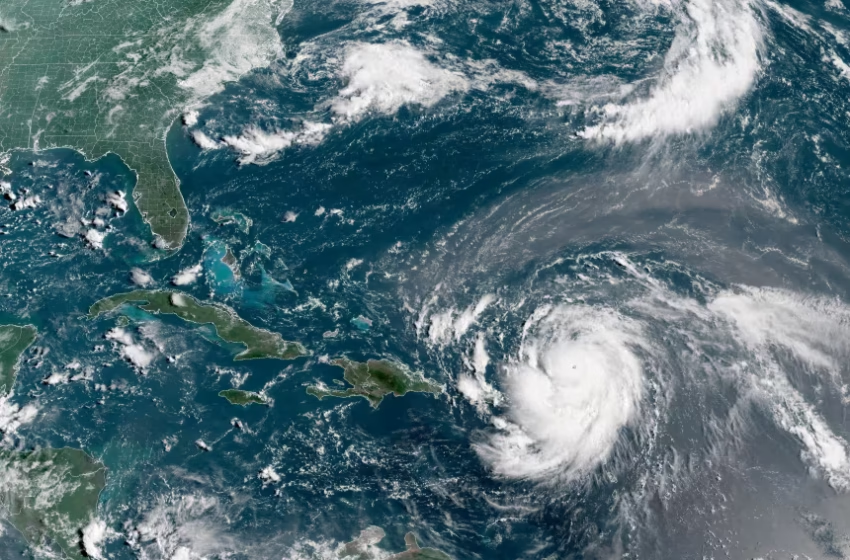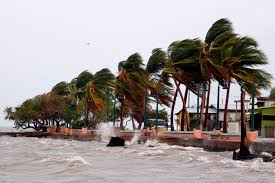Hurricane Erin: What this means for travelers and businesses

Hurricane Erin, which is the first hurricane of the 2025 Atlantic season and has developed into a dangerous Category 4 hurricane, moves westward near Puerto Rico in a composite satellite image on Saturday. Cira/NOAA/Reuters
Hurricane Erin may be staying offshore, but its wide wind field, dangerous surf, and storm surge are already creating cascading impacts along the U.S. East Coast. North Carolina’s Outer Banks has been hit particularly hard, with overwash forcing closures along N.C. Highway 12, evacuations ordered on Hatteras and Ocracoke islands, and widespread beach restrictions in effect. Even as the storm tracks northeast and transitions to a post-tropical system later this week, its ripple effects on travel and commerce are expected to linger.
Travel Impacts & Guidance
Air travel across the Carolinas, Mid-Atlantic, and into the Northeast faces delays and diversions as feeder bands bring low ceilings, wind gusts, and heavy rain. Even airports outside the storm’s core may be affected by ground stops tied to lightning or squalls. Travelers are advised to book earlier departures, avoid tight connections, and monitor airline waivers. Rebooking proactively remains the best way to stay ahead of potential cancellations.
On the roads, N.C. Highway 12 continues to experience closures due to overwash and dune breaches, with the risk of repeated shutdowns during high tides. Drivers should avoid flooded routes altogether, expect detours and bridge wind restrictions, and if travel is necessary, time trips around low-tide windows. Carrying water, chargers, and emergency supplies is strongly recommended in case of gridlock.
Ferry services to Ocracoke are subject to suspension when winds and surge make channels unsafe. Recreational boating has been deemed too dangerous, with offshore seas topping 15–20 feet. Meanwhile, dozens of rip-current rescues have already been reported, prompting beach closures and red flag warnings across much of the coast. Swimmers and surfers are strongly advised to stay out of the water until conditions improve. Rail services in low-lying areas may also face speed restrictions or temporary suspensions if tracks are compromised by surge or sand.
Business Impacts & Actions
For coastal businesses, Erin brings significant challenges. Hotels, rental properties, and restaurants are dealing with cancellations, delayed arrivals, and staffing shortages. Proactive communication with guests—providing updates on road closures, ferry access, and flexible policies—can help minimize disruptions. Businesses should also secure outdoor furniture and signage to reduce damage from wind and surf.
Retailers and fuel providers may experience short-term supply chain hiccups if ferries or coastal highways remain closed. Advance staging of deliveries and backup suppliers is key. Construction and real estate projects are advised to suspend exterior work, secure equipment, and document site conditions for insurance purposes. Ports and logistics operators, though not facing a direct landfall, are likely to encounter delays as long-period swells slow harbor activity and restrict trucking access across bridges.
Continuity planning is crucial. Companies should review their Continuity of Operations (COOP) plans, confirm emergency contacts, and establish remote work protocols where feasible. Insurance clauses for named storms should also be revisited to avoid surprises when filing claims.
Practical Safety Checklists
Travelers should double-check flight statuses the night before and morning of travel, consider moving to earlier flights, and never attempt to drive through floodwaters. Hotels should be contacted in advance for updates on access, power, and beach restrictions. Packing essentials such as medications, chargers, flashlights, food, and water is a must, along with monitoring official emergency alerts.
Businesses should assign an incident response lead, verify staff safety, and safeguard critical assets by moving electronics and inventory to secure locations. Backup data systems, remote POS options, and transparent communication on closures via websites and social media can keep operations running as smoothly as possible. Suppliers and carriers should be notified early of schedule changes, with alternative routes pre-authorized.
Short-Term Outlook
Although Hurricane Erin will not make U.S. landfall, its closest pass—about 200 miles offshore—aligns with astronomical high tides, amplifying risks of overwash, erosion, and rip currents along barrier islands. The system is expected to accelerate northeast and become post-tropical by the weekend, but intermittent disruptions to travel, shipping, and coastal commerce are likely to persist until seas calm and infrastructure inspections are complete.



